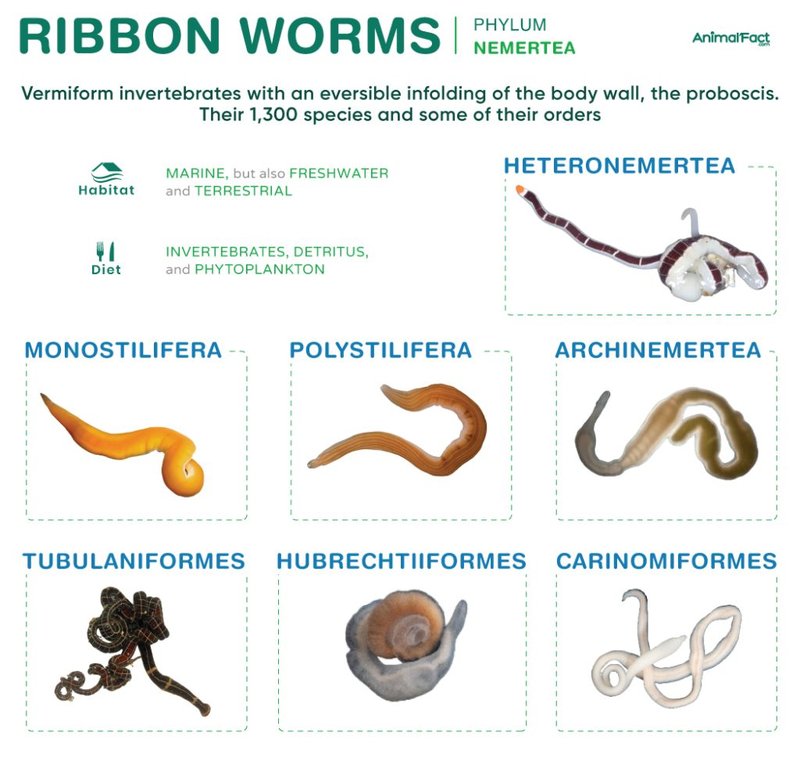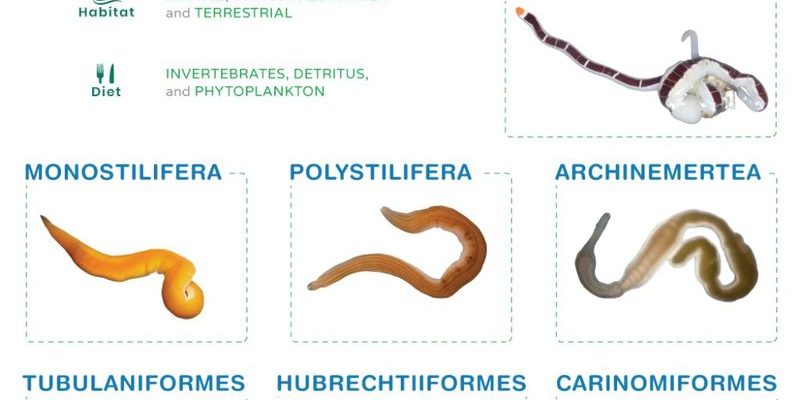
Both types of worms are part of larger ecosystems, playing vital roles in marine and terrestrial habitats. Understanding the striking differences between them can help you appreciate the diversity of life on our planet. So, grab a coffee, and let’s sort through the characteristics, habitats, and lifestyles of ribbon worms and flatworms in a way that makes it all clear and engaging.
What Are Ribbon Worms?
Ribbon worms, known scientifically as *Nemertea*, are long, slender, and often colorful. These fascinating creatures can stretch up to 30 meters in length, making them one of the longest animals in the ocean. You might recognize them by their smooth, flat bodies and their impressive ability to burrow into the sea floor. These guys mainly live in marine environments, but some species can also be found in freshwater and moist terrestrial habitats.
Let me explain a bit about their unique feeding mechanism. Ribbon worms possess a specialized structure called a proboscis, which is essentially a long tube that can be extended and retracted. This proboscis is often equipped with sharp barbs or toxic substances to capture prey, which usually consists of smaller invertebrates. Imagine using a slingshot to catch your food—that’s how these worms snag their meals!
One of the more intriguing aspects of ribbon worms is their regenerative abilities. If a ribbon worm loses part of its body, it can often regenerate that section, making it a topic of scientific interest for studies on healing and regeneration. So, when you think about ribbon worms, picture colorful, elongated creatures that are more than what meets the eye.
What Are Flatworms?
Flatworms, or *Platyhelminthes*, are another fascinating group of worms, but they take a different approach to life. These creatures are, as the name suggests, flat and usually quite small. They can be found in a variety of environments, including marine, freshwater, and even on land. Flatworms come in numerous shapes and sizes, from the familiar planarians to the more specialized parasitic types like tapeworms.
Their flat bodies are a clever adaptation that allows for efficient movement in their environments and better oxygen absorption through their skin. Unlike ribbon worms, flatworms generally don’t have a complicated feeding mechanism. Instead, they rely on a simple mouth located on the underside of their bodies to absorb nutrients directly from their environment or prey. This feeding style is very different from the predatory approach of ribbon worms.
Another remarkable characteristic of flatworms is their complex nervous systems. Some species have eyespots that can detect light, which is a significant evolutionary step. It’s like they have a basic sense of sight, helping them navigate their surroundings. Overall, when you think of flatworms, picture a wide variety of forms and functions, from scavengers to parasites, that highlight the adaptability of life on Earth.
Body Structure: Key Differences
One of the most noticeable differences between ribbon worms and flatworms is their body structure. Ribbon worms have a cylindrical, elongated shape that often gives them a ribbon-like appearance. Their bodies are typically covered in a soft outer layer, which can be colorful or patterned, adding to their visual appeal.
In contrast, flatworms are, well, flat! Their bodies are usually broad and thin, often resembling a leaf or a very thin pancake. This shape might seem simple, but it allows them to thrive in various habitats by facilitating movement across different surfaces. The flatness helps them flatten themselves against rocks or the ocean floor to hide from predators.
Another critical difference is in their internal structures. Ribbon worms have a more complex body plan, featuring a complete digestive system with a mouth and an anus, whereas many flatworms have a more simplified digestive system. Some flatworms even lack an anus altogether, which means they expel waste through the same opening they use to eat. This can seem a bit messy, right? But in the grand scheme of things, it’s just another way these creatures have adapted to their environments.
Habitat and Distribution
When we look at habitat, ribbon worms tend to prefer marine environments, often lurking in the sandy bottoms of oceans or seashores. They can also be found in some freshwater ecosystems, but that’s less common. These worms thrive in areas where they can burrow, using their flexible bodies to navigate the substrate. This preference for specific habitats means that you might encounter them during beachcombing or tide pooling, but they can be elusive!
Flatworms, on the other hand, are a bit more versatile. You can find them in various environments—from freshwater ponds and streams to damp soil or even in some marine settings. Their adaptability is impressive. Some flatworms are even able to live as parasites inside other animals, showcasing just how resourceful they can be. Just think about how you might find a flatworm in a garden or think of them as those undercover operatives of the animal world.
The distribution of these two worm types also varies significantly. While ribbon worms are primarily found in cold and temperate oceans, flatworms can be found all over the globe, from the tropics to the Arctic regions. This geographical spread is a testament to their ability to adapt to different conditions. You might say that flatworms are the jack-of-all-trades of the worm family.
Feeding Habits and Diet
The feeding habits of ribbon worms and flatworms reflect their distinct lifestyles. Ribbon worms are active predators. They hunt for food using their specialized proboscis to capture prey, which usually includes small invertebrates. Think of them as the skilled hunters of the worm world, always on the lookout for their next meal. Their ability to inject toxins into their prey adds an exciting twist to their hunting strategy.
On the flip side, flatworms have a more varied diet depending on their species. Some are scavengers, feeding on decaying organic matter, while others are carnivorous and eat small animals. Parasitic flatworms, like tapeworms, have a much different style—absorb nutrients directly from their hosts, which makes them quite the unique and crafty bunch.
Here’s a fun fact: flatworms can actually regenerate lost body parts, similar to ribbon worms, but they do so through different biological processes. This ability helps them survive in the wild, whether it’s escaping from predators or recovering from injuries.
Reproduction and Life Cycle
When it comes to reproduction, both ribbon worms and flatworms exhibit fascinating methods, but they differ in significant ways. Ribbon worms often reproduce sexually, with some species also capable of asexual reproduction through fragmentation. This means that if part of a ribbon worm breaks off, it can grow into a new individual. It’s like every little piece has the potential to become a whole new worm!
Flatworms are especially interesting in this department. Many species are hermaphroditic, meaning they have both male and female reproductive organs. This characteristic can make mating a bit more straightforward since they don’t need to find a mate of the opposite sex—they can partner up with any flatworm they encounter! This adaptability can be quite beneficial in environments where partners are hard to come by.
Flatworms also have an intriguing life cycle, particularly the parasitic types. They often go through several stages, including egg, larva, and adult forms, sometimes requiring multiple hosts. Imagine living in two different bodies over your life, which makes their life cycle quite complex! Overall, the various reproductive strategies shed light on the adaptability and resilience of both ribbon worms and flatworms.
Summary of Differences
Here’s a quick recap of the key differences between ribbon worms and flatworms to make it all easier to remember:
| Feature | Ribbon Worms | Flatworms |
| Body Shape | Cylindrical and elongated | Flat and broad |
| Habitat | Primarily marine | Diverse environments (marine, freshwater, terrestrial) |
| Feeding Method | Active predators with a proboscis | Varied; scavengers or parasites |
| Reproductive Strategy | Sexual and asexual reproduction | Hermaphroditic, often changing hosts |
This table summarizes the most notable differences, giving you a quick reference point to see how these two fascinating types of worms compare.
In conclusion, understanding the differences between ribbon worms and flatworms not only enriches your knowledge about these unique creatures but also highlights the incredible diversity of life on Earth. Whether it’s their body structure, habitats, feeding habits, or reproductive strategies, each group has its own special adaptations that allow them to thrive. So, next time you spot a worm in the garden or while beachcombing, take a moment to appreciate the tiny marvels of nature. You never know what fascinating story they might hold!

